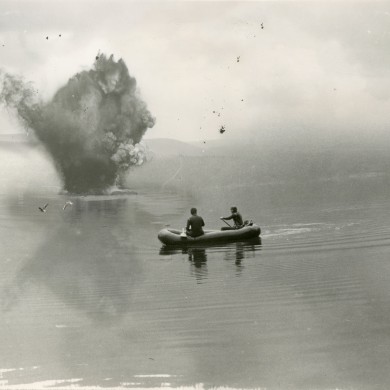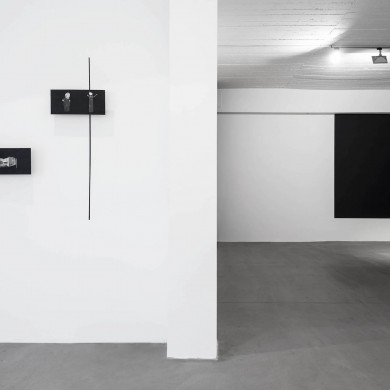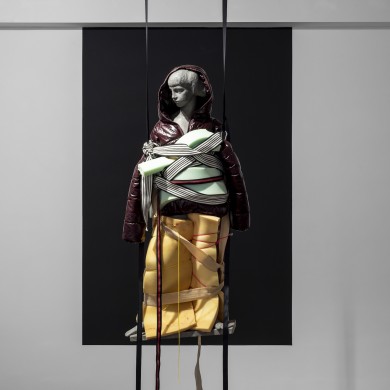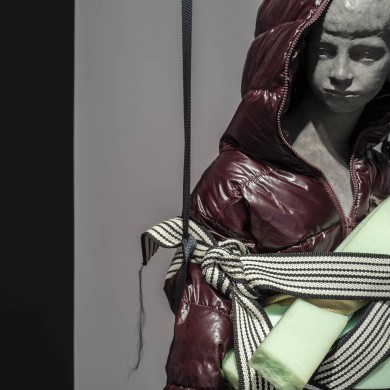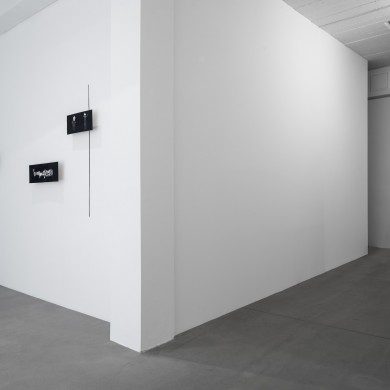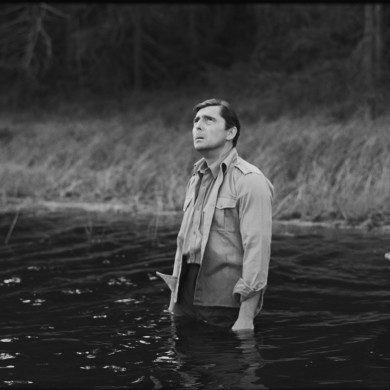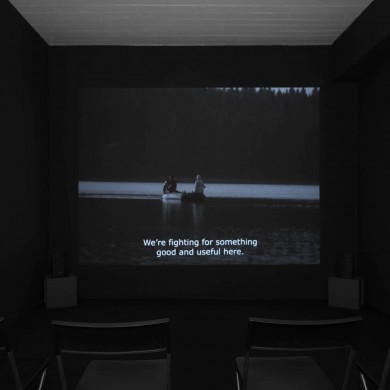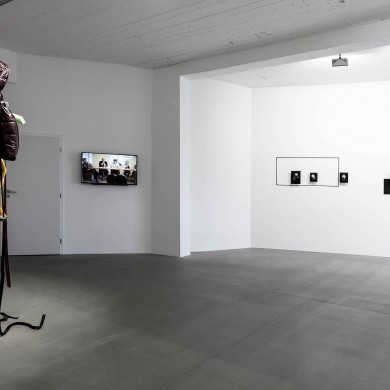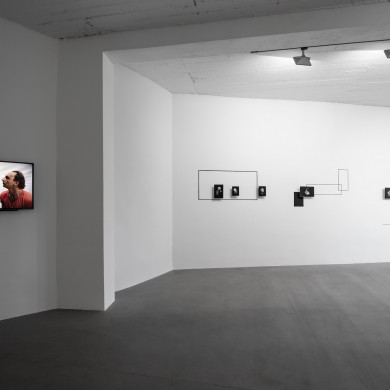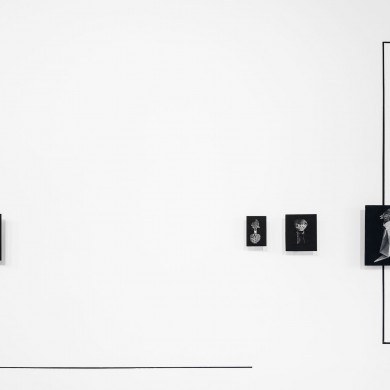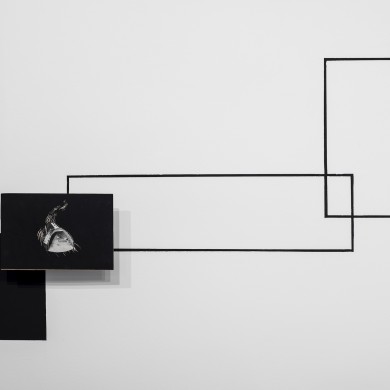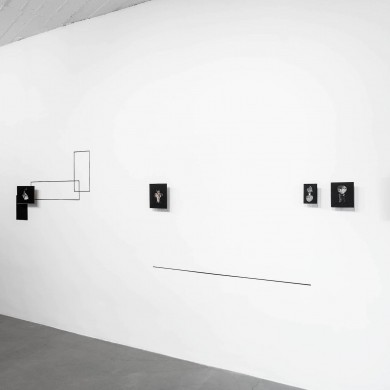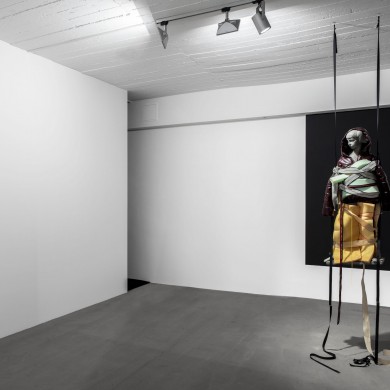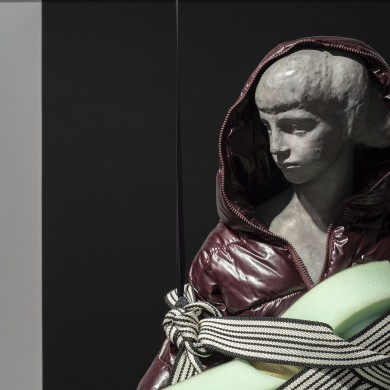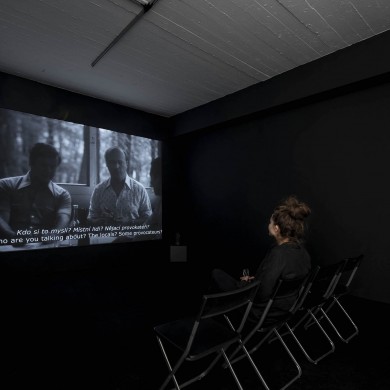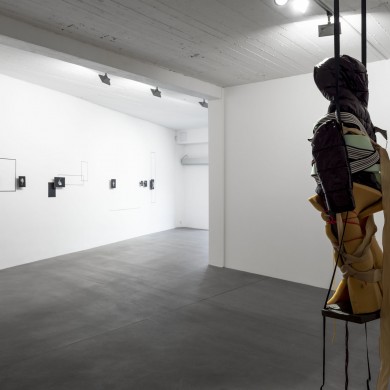Adéla Babanová | Neptune
curated by Jen Kratochvil
Guests: Hynek Alt, Christian Kosmas Mayer and Daniel Pitín
31 Jan – 25 April 2019
ZAHORIAN & VAN ESPEN Bratislava
The story of our past is not merely given. It is a complex construction of carefully interwoven narratives, forging a coherent memory and corresponding national behavior. People and parties in power have the prerogative of defining what we consider to be our history, while burying fragments which do not fit and which contradict the desired larger picture. The Second World War, the Cold War, Vietnam, 1989: all of those milestones of our constitutive modern historical canon are interpreted in a specific fashion which leads us to believe in simplified, almost mythologically formulated black and white struggles between opposing forces of good and evil. Neptune is presenting a series of takes on this approach from the position of contemporary artists dealing with our history, in forms which may be mainly literal or more symbolic, representing a path which leads us to our own time.
_______________________________________
In 1964, the Interior Ministry of the Czechoslovak Socialist Republic established a Soviet-type Department of Active Measures, which functioned with the support and under the supervision of the KGB. The objective of this secret division was the spreading of disinformation and propaganda in local and international media, the falsification of official documents, and the perpetration of political assassinations and repressive measures. One of the two protagonists of Adéla Babanová’s new film Neptune, Ladislav Bittman, known at the time by the alias Vladimír Brychta, was a member of this department.
After the occupation of Czechoslovakia by Warsaw Pact armies in 1968, Bittman emigrated to the US, where he revealed details of the activities of the department, including one of its key operations codenamed Operation Neptune, before a hearing of the US Congress.
While the crew of an entertaining and educational television programme called Zvědavá kamera (Curious Camera) was filming a documentary about the fabled glacial lakes of the Bohemian Forest, the disinformation department staged the discovery of chests containing fake documents, allegedly hidden on the bottom of one of the lakes by Nazi soldiers during their retreat in 1945. At the time of the ‘discovery,’ the carefully prepared, authentic-looking chests were empty. The documents, which were intended to compromise West German politicians by revealing their Nazi past, thus leading to the extension of the statute of limitations on prosecuting Nazi crimes, were only delivered from Moscow later. The entire operation was exceptionally successful and well received by the general public, both at home and abroad. Bittman was one of the divers who ‘discovered’ the chests in the lake, having placed them there in the first place.
Together with her brother Džian, who wrote the screenplay, Adéla Babanová overlays manipulated ‘truth’ with an additional sprinkling of uncertainty. The boundary between reality and fiction is thus seldom recognisable, ceasing to be important as the film progresses and its dramatic dynamic intensifies. The film’s impression of belonging to the documentary genre undergoes several dynamic changes, climaxing in an almost Lynchian, surreal and dream-like denouement. It extends the timeline of the era of post-truth and shows us that our epoch is very much rooted in the past.
When the state police forged Operation Neptune, a complex net of references came into play in an assault on public sentiments: local imagination (an old prevailing belief that the lake is cursed); a constructed image, implanted in the general public’s memory, of fleeing Nazis burying documents and stolen treasures in border areas (Czechoslovak films produced in the 1950s depicted several stories about such materials being discovered); and an idea of scientific progress through exploration of previously unknown deep realms beneath the dark waters, negating the first-mentioned idea, diminishing old legends and rewriting them with new ones. Adéla is blurring all these layers with a new surreal story. By placing her fantastic fable on top of existing manipulations, she’s literally breaking apart a house of cards of lies and fiction transforming them into a dream-like scenario.
Adéla’s Neptune is juxtaposed with works by her colleagues, utilizing them within her strategies of appropriating found material to navigate through a complex web of historical references. She groups and grounds them in the contemporary social and political climate, so as to emphasize the formative role of the past in our current discourse.
Hynek Alt is literally lifting up a sculpture of Miloš Zet, Czech sculptor active in the period of 1960s-1980s. Miloš Zet was a devoted communist, entering the party full of idealism right after the war. Changes of the political climate in the aftermath of the Prague Spring let to his expulsion in 1970. The statue, called “Young Day,” made in the same year as the Operation Neptune took place, is depicting a girl on the threshold of adolescence, full of life and energy ready to dutifully dedicate it to fulfilment of her role in building a new, just and positive future. Zet’s artworks were almost exclusively placed in the public space of socialist Czechoslovakia, conceived as integral parts of the complex architectural plan of an area or a building. For the socialist public they provided a manifestation of traditionally grounded beauty, mostly with a background of newly revived, restrained modernism, which after the death of Stalin and EXPO58 replaced the formerly dominant socialist realism. His sculptures were a natural part of a new organisation of the society, based on appreciation of similar values and forms as in Ancient Greece, re-verbalised by the renaissance, and further rediscovered by humanism after the WW2. “Young Day” was made in two copies cast in bronze. The first copy can be traced to a spa area in Teplice nad Bečvou, and the second found its location in Ostrava, Poruba. Through the collaboration of Hynek and Miloš Zet’s son Martin (also an artist), a plaster cast of “Young Day”, stored in Miloš Zet’s studio for decades, was given a new life opportunity in Hynek’s appropriation, called simply “Untitled (Young Day)”, 2018. By bounding the sculpture in transport straps and elevating it above the ground, giving it a sensation of weightlessness and levitation on the one hand, on the other a feeling of transfer or contingency of a new meaning, Hynek writes a next chapter in the life of this historical form. When the statue lifts up, its history comes with it, even though without a trained eye one can hardly trace its origin due to the relatively generic figurative style applied. It is quite likely that without mentioning it, you wouldn’t even associate her legacy with the period of the 1960s. Does she belong there or not, if we actually don’t realize it? Is the past only what we know about it or rather what we are told to believe?
The binding that holds the sculptures in place is carefully recreated, using a series of documentary images of various historical artworks prepared for a shipment. The original concept behind “Untitled” placed it on a darkened stage in a theatre for a brief span of one minute, presenting it almost as a spectre of its challenging past. As part of Neptune, the object receives the attention of the exhibition format, an intact place in time and space. The fact of levitation nevertheless displaces this status into an endless transition. As if the course of history were be halted in a single glimpse of a second, motionless, stuck in a movement of a minute hand which is not going forward any more, repeatedly announcing an uncanny revelation that time is no more.
Christian Kosmas Mayer’s video ULAM, 2013 presents us with a lesson in a language representing communication between men of the Stone Age some 80,000 years ago. The only problem is that we actually have no notion of how people of that era spoke. This language, called Ulam (as is the video), was artificially conceived for the 1981 film “Le guerre du feu” (Quest for Fire) by the French director Jean-Jacques Annaud, known for his 1981 adaptation of Umberto Eco’s “The Name of the Rose”. The creators of the language are the English writer and composer Anthony Burgess, known mainly for his dystopian satire A Clockwork Orange, and Desmond Morris, English zoologist, ethologist and surrealist painter, as well as a popular author in human sociobiology. Ulam is based on colourful vocal expressions formulated by Burgess and a rich gestural apparatus choreographed by Morris. Sentences like “I am hungry for tiger meat” are constructed from a study of the oldest languages of which we have a vocal knowledge, going thousands of years back and trying to find some approximation to what could have been a native tongue of our distant ancestors. Christian Kosmas takes original footage from the rehearsals with the actors of the film, combining them with interviews he did with Bibi Caspari, one of the actresses, and newly reconstructed “language courses” with a group of performers. He is thinking about Ulam as a possibly existing language which only a handful of people are still able to use, in an attempt to spread knowledge of it and to save such a treasure of the past from oblivion. In this way he addresses the essential issue of dying languages. According to a statistic, from a total of approximately 7000 currently existing languages, one endangered language becomes extinct every two weeks. Besides which, the application of fiction, or let’s say human imagination, plays a significant role in real circumstances.
Popular culture is able to produce complex new systems which could through conviction of its fans overcome its original purpose. Probably the most widespread phenomenon of this sort is Klingon, the language of an adversary race of the same name in almost endless series of Star Trek TV shows, films, novels, and computer games. Not only that Star Trek buffs dress up as numerous characters and races introduced in ST, they also helped to formulate a comprehensive vocabulary and grammar of one of the most used alien languages. If we can speak as a warrior race from a possible distant future, why not as our own long lost ancestors?
Black and white images of late modernistic architecture and interior design, ornaments, and almost unrecognizable bits and pieces of figures and other creatures, abstracted forms, and various additional visual stimuli, contribute to the creation of Daniel Pitín’s elaborate collages. Pitín reaches out for the same strategies and visual language as in his paintings and films, though in this case with much more focused and concentrated attention to the single detail, taken as a constitutive element of a new reality for the original found material being utilised. The images forming this particular series emphasize the role of the singular item, while in his paintings or films these specificities cross-connect in a net of relationships to present a bigger picture, environment or situation. The reason for this approach could be that the present series, entitled “Little Animals”, was conceived as integral elements of a site-specific installation for the church of Saint Salvador in Prague, where they interacted on a sculptural set with the baroque-style architecture of the venue. This time they stand almost alone, but even here the negation of the traditional two-dimensional setting, typical for adjusting collages, comes into play. In remembrance of the original installation, the collages are interwoven into a simple grid, or rather a promise of a grid made with paint on the wall underneath. The collages are partially stepping out of the wall, as if they were literally crying out for a spatial setting rather than the merely flat form they are assigned to.
Daniel’s collages are showing a possibility to restructure past inputs into a new coherent assembly without gravity of their original context. Conceiving a previously unfamiliar state of things, which is becoming a reality of the moment. The history of cinema, along with late-modern architecture, and their commonly shared and recognisable visual heritage, form the backbone of Daniel’s oeuvre, onto which current socio-political issues are attached like flesh and tissue. He thus creates a body of work in which our perception naturally slides back and forth on the timeline without friction, allowing us to perceive the individual elements in constant confrontation with their counterparts, no matter how improbable those may be.
_______________________________________
The reason why the state police of socialist Czechoslovakia named their operation after the Ancient Roman god of the sea and freshwater seems to be obvious, since their elaborate scheme literally came out of the depths of the water of the glacial lake. This is reinforced by the sinister role the Devil’s lake played in local legends. What is probably more interesting in this context is the fact that Neptune, like the rest of the Roman heavenly pantheon, is appropriated from older existing Greek tradition, specifically in this case from the figure of Poseidon. One complex system of religious beliefs, and the genealogy of immortals, is taken and adapted by another culture without much of an attempt to cover up the evident similarities. The historical tradition is rewritten to serve the narrative of a new dominant political power. Stories manipulating the past in our own context are much more sophisticated, reflecting the more advanced general knowledge in present-day Europe, thanks to the widespread use of information media. The methodology is the same, however. We still hold on to the idea that reality and fiction are two separate systems, that facts belong to a particular time and place – a belief that all of the works presented are challenging and negating. Current rapid developments in virtual and augmented realities are heading in the same direction and will most probably teach us how to understand our reality as a permutable collage.
Adela Babanová
*1980 in Prague, lives and works in Prague
&
Hynek Alt
*1976 in Kutná Hora, lives and works in Prague
Christian Kosmas Mayer
*1976 in Sigmaringen, Germany, lives and works in Vienna
Daniel Pitín
*1977 in Prague, lives and works in Prague
Supported using public funding by Slovak Arts Council as main partner![]()
Co-organizer of the exhibition: Czech Centre in Bratislava. Media partners: Flash Art and Radio FM
Adéla Babanová | Neptun
kurátor: Jen Kratochvil
hostia výstavy: Hynek Alt, Christian Kosmas Mayer and Daniel Pitín
31.1. – 25. 4. 2019
ZAHORIAN & VAN ESPEN Bratislava
Príbeh našej minulosti nie je výlučne daný. Je to skôr zložitá konštrukcia starostlivo a úzko prepojených príbehov, ktoré spoločne vytvárajú súvislú pamäť a jej zodpovedajúce národné charakteristiky. Ľudia v mocenských pozíciách a vládnuce politické strany si privlastňujú privilégium definovať, čo máme považovať za naše dejiny, a zároveň ničiť tie fragmenty, ktoré do tejto schémy nezapadajú, či priam požadovanému celkovému obrazu protirečia. Druhá svetová vojna, studená vojna, vietnamská vojna, rok 1989… všetky míľniky konštitutívneho kánonu našich moderných dejín sa interpretujú špecifickým spôsobom, čo nás vedie k viere v zjednodušené, takmer mytologicky formulované čierno-biele zápasy medzi protichodnými silami dobra a zla. Neptún predstavuje niekoľko sérií zachytení tohto prístupu z pozície súčasných umelcov a umelkýň, ktorí spracúvajú naše dejiny, či už vo väčšmi literárnej alebo v symbolických formách. Tým vytvárajú cestičku, ktorá nás vovádza do našich vlastných čias.
______________________________________
V roku 1964 zriadilo Ministerstvo vnútra Československej socialistickej republiky podľa sovietskeho vzoru nový odbor aktívnych opatrení, ktorý pracoval s podporou a pod dohľadom KGB. Cieľom tohto nového oddelenia rozviedky bolo šíriť dezinformácie a propagandu v národných a medzinárodných médiách, falzifikovať úradné dokumenty a vykonávať politické vraždy a represie. Ladislav Bittman, jeden z dvoch protagonistov nového filmu Adély Babanovej Neptún, v danom období známy pod falošným menom Vladimír Brychta, bol členom tohto odboru.
Po obsadení Československa vojskami štátov Varšavskej zmluvy v roku 1968 Bittman emigroval do USA, kde detaily činnosti odboru, vrátane zásadnej operácie známej pod krycím názvom Akcia Neptún, opísal pred Kongresom.
Keď redaktori zábavno-vzdelávacieho televízneho programu Zvedavá kamera (Curious Camera) nakrúcali dokumentárny film o povestných ľadovcových jazerách šumavských lesov, dezinformačné oddelenie nafingovalo objav štyroch debien s falošnými dokumentmi, ktoré na dne jedného z jazier údajne zanechali nacistickí vojaci počas ústupu v roku 1945. V čase „objavu“ boli tieto starostlivo pripravené a vierohodne vyzerajúce debny prázdne. Dokumenty, ktoré mali skompromitovať vtedajších západonemeckých politikov odhalením ich nacistickej minulosti a docieliť tak predĺženie lehoty premlčania nacistických zločinov, Moskva dodala až neskôr.
Akcia mala výnimočný úspech, stretla sa s pozitívnym ohlasom na domácej aj medzinárodnej pôde. Bittman bol jedným z potápačov, ktorí debny na dne jazera „objavili“. Priamo sa totiž zúčastňoval aj ich tajného ukladania.
Spoločne s bratom Džianom, ktorý je autorom scenára, Adéla Babanová prekrýva zmanipulovanú „pravdu“ dodatočným popraškom neistoty. Hranica medzi skutočnosťou a fikciou sa tak dá zriedka rozpoznať: Ako film plynie, jeho dynamika sa dramaticky zintenzívňuje a to, čo je skutočné a čo je už fikcia, postupne stráca na význame.
Prvotný dojem, na základe ktorého by sme film automaticky zaradili do dokumentárneho žánru, prechádza niekoľkými dynamickými zmenami. Vyvrcholí v takmer „lynchovskom“, surrealistickom, snovom rozuzlení. Predlžuje časovú os post-pravdivej éry a ukazuje, ako veľmi je naša súčasnosť zakorenená v minulosti.
Keď štátna bezpečnosť pripravovala Akciu Neptún, verejnú citlivosť útočila celou radou sofistikovaných, vzájomne poprepájaných kultúrnych odkazov: Využila prežívajúcu kolektívnu predstavivosť, ktorá sa živila starou a rozšírenou poverou, že jazero je prekliate; vytvorila a do existujúcej spoločenskej pamäte začlenila obraz utekajúcich nacistov, ktorí zakopávajú dokumenty a ukradnuté poklady v hraničných oblastiach – československá filmová produkcia 50. rokov vykreslila niekoľko príbehov o podobných objavoch; a v neposlednom rade použila ideu vedeckého pokroku, ktorý umožňuje objavovať doposiaľ neznáme hlbiny pod tmavou hladinou vôd, čo staré povery popiera a prepisuje ich novými.
Adéla jasné kontúry všetkých týchto vrstiev rozmazáva novým, surrealistickým príbehom. Tým, že svoju fantastickú bájku umiestňuje celkom na vrchol existujúcich manipulácií, doslova rúca domček z karát lží a výmyslov, a pretvára ich do snového scenára.
Neptún Adély Babanovej stojí v juxtapozícii s prácami jej kolegov, ktorí rovnako ako ona využívajú stratégiu apropriácie, prisvojenia si nájdeného materiálu, ktorý ich vedie komplexnou sieťou historických odkazov, zoskupuje a začleňuje ich do súčasnej sociálnej
a politickej klímy. To zdôrazňuje formatívnu úlohu minulosti v našom momentálnom diskurze.
Hynek Alt doslova nadvihuje sochu Miloša Zeta, českého sochára pôsobiaceho v období od 60. do 80. rokov minulého storočia. Miloš Zet bol oddaný komunista, plný ideálov vstúpil do Komunistickej strany hneď po vojne. Zmena politickej klímy v dôsledku Pražskej jari spôsobila, že v roku 1970 ho zo strany vyhodili. Socha pomenovaná „Mladý deň“, ktorá vznikla v tom istom roku, ako sa konala Akcia Neptún, stvárňuje dievča na prahu puberty, plné života a energie, pripravené svedomito ich venovať napĺňaniu svojej role pri budovaní novej, spravodlivej a pozitívnej budúcnosti. Zetove umelecké diela sa vystavovali takmer výlučne na verejných priestranstvách v socialistickom Československu a vznikali ako integrálne súčasti komplexného architektonického riešenia priestoru alebo budovy. Socialistickej verejnosti sprostredkúval zhmotnenie tradične potláčanej krásy, najčastejšie na pozadí nanovo oživeného mierneho modernizmu, ktorý na výstave EXPO58, už po Stalinovej smrti, nahradil pôvodne dominantný socialistický realizmus. Jeho sochy tvorili prirodzenú súčasť novej organizácie spoločnosti, založenej na vyznávaní podobných hodnôt a foriem ako v antickom Grécku, opätovne formulovanými v renesancii, aby ich neskôr po druhej svetovej vojne znovuobjavil humanistický étos.
„Mladý deň“ vznikol v dvoch kópiách odliatych do bronzu. Prvá sa nachádza v areáli kúpeľov v Tepliciach nad Bečvou, druhá bola umiestnená v ostravskej mestskej časti Poruba.
Výskumom pozostalosti Miloša Zeta vdýchol Hynek Alt so Zetovým synom Martinom, takisto umelcom, nový život sadrovému odliatku „Mladého dňa“. Ten sa desaťročia nachádzal v ateliéri Miloša Zeta v podobe Hynkovej apropriácie nazvanej prosto „Bez mena (Mladý deň)“, 2018. Hynek sochu previazal sťahovacími remeňmi, pomocou ktorých ju nadvihol. Na jednej strane tak docielil pocit beztiaže a levitácie, na strane druhej pocit prenesenia alebo eventuality nového významu. V živote tejto historickej formy tak Hynek napísal ďalšiu kapitolu.
Keď sa socha nadvihne, ukáže sa jej príbeh, hoci netrénované oko si vzhľadom na pomerne štandardný figuratívny štýl sotva uvedomí jej pôvod. Keby o tom divák nebol informovaný, možno by si ju ani nedal do spojitosti s obdobím šesťdesiatych rokov.
Je teda možné povedať, či do nich patrí alebo nepatrí, ak si to ani neuvedomujeme? Je minulosť len to, čo o nej vieme, ale skôr to, čomu máme veriť?
Obal, do ktorého sú stiahnuté sochy, je starostlivo zrekonštruovaný na základe sérií dokumentačných fotografií rôznych historických umeleckých diel pripravených na prevoz loďou. Pôvodný koncept diela „Bez mena“ ich na krátku minútu umiestňoval na tmavú divadelnú scénu, čím ich predstavil skoro ako prízrak náročnej minulosti. Ako súčasť Neptúnu dosahuje objekt výstavný formát, je intaktným miestom v čase a priestore. Ale levitácia predsa túto úlohu posúva až do polohy nekonečnej zmeny. Akoby sa chod dejín
v stotine sekundy zastavil, ostal nehybný, ustrnutý v poslednom pohybe hodinovej ručičky, ktorá sa viac nehýbe, opakovane zdôrazňujúc podivné poznanie, že čas viac neexistuje. A to je práve naša príležitosť zamyslieť sa.
Video Christiana Kosmasa Mayera ULAM z roku 2013 predstavuje lekciu jazyka, ktorým komunikovali ľudia v dobe kamennej pred 80-tisíc rokmi. Problém však je, že my vôbec nevieme, ako ľudia tej doby rozprávali. Ich jazyk, pomenovaný rovnako ako video Ulam, umelo vznikol pre potreby filmu z roku 1981 La Guerre du feu (Boj o oheň) v réžii Jeana-Jacquesa Annauda, ktorý vstúpil do povedomia najmä svojou adaptáciou románu Umberta Ecca Meno ruže v roku 1986.
Autorom mýtického jazyka boli spisovateľ a skladateľ Anthony Burgess, známy najmä dystopickou satirou Mechanický pomaranč (1962), a Desmond Morris, anglický zoológ, etológ, surrealistický maliar a autor populárnych kníh o ľudskej sociobiológii. Základom jazyka Ulam sú farebné vokálne výrazy, ktoré vytvoril Burgess, a bohatý aparát gestiky zostavený Morrisom.
Výrazy ako „som hladný po tigrom mäse“ sú vytvorené podľa štúdií najstarších jazykov, ktorých znenie je nám podnes čiastočne známe, ale v pokuse objaviť približné vyjadrenie jazyka, ktorým mohli naši dávni predkovia rozprávať, sa posúvajú o tisícročia dozadu.
Christian Kosmas Mayer pracuje s pôvodnými filmovými zábermi z hereckých skúšok filmu a kombinuje ich jednak s rozhovormi, ktoré urobil s herečkou Bibi Caspari a jednak s „jazykovými kurzami“, kde vystupuje skupina performerov. O Ulame uvažuje ako o stále existujúcom jazyku, ktorým ešte rozpráva neveľká skupina ľudí. Pokúša sa tak šíriť poznatky, ktoré sú v ňom uchované, a zachrániť tak tieto poklady minulosti pred upadnutím do zabudnutia. Týmto spôsobom sa vyjadruje k téme vymierajúcich jazykov. Momentálne existuje približne sedem tisíc jazykov.
Niektoré sú v ohrození zániku, a z nich každý druhý týždeň jeden vymrie.
Významnú úlohu tiež hrá uplatňovanie fikcie, či skôr ľudskej predstavivosti v reálnych podmienkach. Populárna kultúra je schopná vyprodukovať celé zložité nové systémy, ktoré sa vďaka zanieteniu svojich prívržencov stávajú pôvodným úmyslom. Vari najrozšírenejším fenoménom tohto druhu je klingončina, jazyk nepriateľskej rasy Klingonov v nekonečných mediálnych sériách Star Trek – televíznych seriálov, celovečerných filmov, románov, komiksov či videohier. Fanúšikovia mediálnej rady sa nielen obliekajú ako postavy a rasy vystupujúce v Star Treku, ale paralelne umožňujú vytvárať komplexný slovník a gramatiku jedného z najpoužívanejších umelých jazykov. Ak teda dokážeme rozprávať ako bojovnícka rasa možnej vzdialenej budúcnosti, prečo nie ako naši vzdialení pravekí predkovia?
Čierno-biele fotografie neskorej modernistickej architektúry a vnútorného dizajnu, ornamenty, takmer nerozoznateľní útržky a časti postáv a iných bytostí, abstraktné formy
a mnohé doplnkové vizuálne stimuly – to všetko stojí za zložitými kolážami Daniela Pitína. Pitín sa usiluje o rovnaké stratégie a vizuálny jazyk ako vo svojich kresbách a filmoch.
V tomto prípade sa oale veľa väčšmi zameriava a sústredí pozornosť na drobný detail, ktorý je stavebným elementom novej reality pre použitý alebo nájdený materiál.
Obrazy, ktoré tvoria tieto série, podčiarkujú úlohu jednotlivostí, ale podobné zvláštnosti v jeho maľbách alebo filmoch skôr vytvárajú sieť vzájomných vzťahov. Tak vzniká celistvejší obraz, prostredie alebo situácia.
Príčinou tohto postupu je aj to, že uvedené série s názvom „Zvieratká“ boli pôvodne zamýšľané ako integrálne súčasti inštalácie v špecifickom priestore kostola Svätého Salvátora v Prahe, kde nutne interagovali s barokovou architektúrou miesta.
Teraz stoja prakticky samostatne, hoci aj tu do hry vstupuje negácia tradičného dvojdimenziálneho prostredia typického pre upravované koláže. Ako pripomienka pôvodnej inštalácie sú koláže vpletené do jednoduchej mriežky, či skôr niečoho ako prísľub mriežky, načrtnutej farbou na stene pod inštaláciou. Koláže čiastočne vystupujú zo steny, akoby volali po priestorovej, nie plochej forme. Danielove koláže ukazujú, ako sa dá meniť štruktúra minulosti do podoby nového koherentného celku, bez závažnosti pôvodného kontextu. Vzniká tak predstava o predtým neznámom stave vecí, ktoré sa stávajú skutočnosťou danej chvíle.
Opornú kostru Danielovej tvorby tvoria dejiny filmu ako aj neskorá modernistická architektúra a ich spoločné, na prvý pohľad rozpoznateľné vizuálne dedičstvo. Naňho sa ako látka na kožu pridávajú súčasné sociálne a politické záležitosti. Tak vzniká dielo, v ktorom sa naše vnímanie prirodzene a bez prekážok kĺže dozadu aj dopredu. Vďaka tomu si individuálne prvky uvedomujeme v ustavičnej konfrontácii so svojimi proťajškami, bez ohľadu na ich nepravdepodobnosť.
_______________________________________
Dôvod, prečo bezpečnostná polícia socialistického Československa pomenovala svoju operáciu podľa starorímskeho boha všetkých vôd, je očividný. Dokonalo vypracovaná schéma doslova vyvrela z hĺbky vôd ľadovcového jazera a spontánne ju ešte spevnila povesť o diablovi, ktorý v jazere podľa starých legiend prebýval. V našom kontexte je však oveľa zaujímavejšie, že Neptún, rovnako ako celý panteón starorímskych bohov a bohýň, je len osvojením oveľa staršej gréckej tradície. V tomto prípade ide o starogréckeho boha Poseidóna. Celý jeden ucelený systém náboženských predstáv a rodokmeň nesmrteľníkov preberie a pre svoje potreby prispôsobí iná kultúra, a ani sa pri tom neusiluje zatajiť očividné podobnosti. Historická tradícia sa nanovo prepíše, aby slúžila naratívu novej vládnucej politickej moci. Príbehy manipulácie minulosti sú v našom prípade oveľa sofistikovanejšie,
a to najmä zásluhou širšieho všeobecného vzdelania modernej Európy v dôsledku širokej dostupnosti informačných médií. Ale postup je tak či onak rovnaký. Stále trváme na predstave, že skutočnosť a fikcia sú dva oddelené systémy, že fakty prináležia konkrétnemu času a priestoru, že vystavené práce majú k niečomu vyzývať alebo niečo popierať. Súčasný rýchly vývoj virtuálnej aj predĺženej reality sa uberajú rovnakým smerom
a pravdepodobne nás naučia, že našu realitu musíme vnímať ako koláž preskupovaných poradí.
Adéla Babanová *1980 v Prahe, žije a pracuje v Prahe
&
Hynek Alt *1976 v Kutnej Hore, žije a pracuje v Prahe
Christian Kosmas Mayer *1976 v Sigmaringene, Nemecko, žije a pracuje vo Viedni
Daniel Pitín *1977 v Prahe, žije a pracuje v Prahe
Fotoreport: Marko Horban
Projekt podporil z verejných zdrojov Fond na podporu umenia ako hlavný partner![]()
Spoluorganizátor akcie : České centrum v Bratislave. Mediálni partneri: Flash Art, Rádio FM
